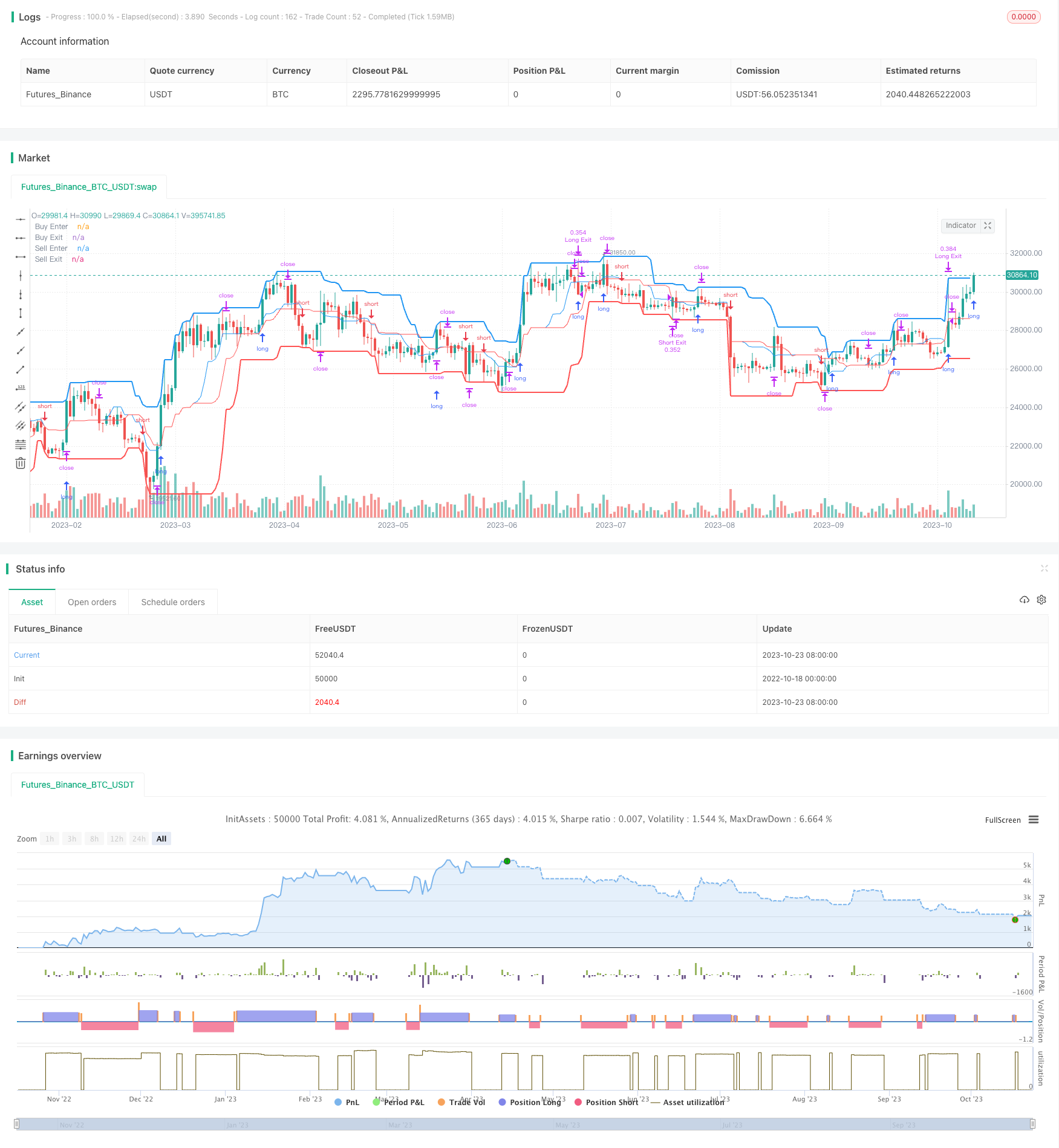短期取引戦略
作者: リン・ハーンチャオチャン開催日:2023年10月25日 14:40:21タグ:

概要
これは,チャネルブレイクに基づいた短期的取引戦略である.チャネルの上下レールのブレイクを使用して,トレンドの始まりと終わりを決定し,それに応じて取引決定を行う. 強いトレンド市場では,このブレイクアウト戦略は立派な利益を生むことができます.
戦略の論理
-
この戦略では,まず,運河の上下線を建設するために,一定の期間における最高高位と最低低位を計算する.
-
価格が上方レールの上を突破したら,ロング,下方レールの下を突破したらショート.
-
リスクを制御するために移動ストップ損失を使用します.ストップ損失はチャネルの中央線に設定されています.
-
選択可能な出口ルールは2つあります. 中央線に戻り,または移動ストップ損失に従う.前者は利益を迅速に実現し,後者はリスクを制御します.
-
チャンネル期間や他のパラメータを調整して,異なる市場条件に最適化することができます.
利点分析
-
価格・チャネル関係を監視し 取引のルールを遵守するだけです
-
トレンドに沿って取引する 逆トレンドリスクはない
-
透明で直感的なチャネルは 明確な入口信号を与えます
-
良い利益率は,ほとんどの場合満足のいく利益を得ることができます.
-
様々な市場での最適化のために多くの調整可能なパラメータがあります
リスク分析
-
脱出は失敗するかもしれない 閉じ込められる危険性がある 時間内にストップ損失が必要
-
チャンネルは形成に時間がかかるので 範囲限定市場には適していません
-
中途半端のストップ損失に戻ることは,傾向を維持できないので,あまりにも保守的かもしれません.
-
パラメータ最適化には 履歴データが必要で リアルタイムの取引では オーバーフィットが可能です
-
ブレイクポイントの機械的取引は,取引頻度とスライプコストを増加させる可能性があります.
オプティマイゼーションの方向性
-
異なる時期のチャンネルを評価し,最適なチャンネルを選択します.
-
中央に戻り,ストップ損失を移動して,より良い出口メカニズムを見つける.
-
ストップ・ロスの割合を最適化して ストップ・アウトの可能性を減らす
-
トレンドフィルターを追加して不適切なブレイクトレードを避ける.
-
ポジションの大きさを増やしてリスクをコントロールする
概要
一般的に,これは成熟した短期的なブレイクアウト戦略である. 明確なエントリールール,適切なリスク制御,そして一般的に良好な機能がある. パラメータ調整によってさらなる改善を達成することができる. しかし,固有の制限,異なる市場のために必要な調整を注意すべきである. 体系的に使用した場合,一貫した全体的な利益をもたらすべきである.
/*backtest
start: 2022-10-18 00:00:00
end: 2023-10-24 00:00:00
period: 1d
basePeriod: 1h
exchanges: [{"eid":"Futures_Binance","currency":"BTC_USDT"}]
*/
// This source code is subject to the terms of the Mozilla Public License 2.0 at https://mozilla.org/MPL/2.0/
// Strategy testing and optimisation for free Bitmex trading bot
// © algotradingcc
//@version=4
strategy("Channel Break [for free bot]", overlay=true, default_qty_type= strategy.percent_of_equity, initial_capital = 1000, default_qty_value = 20, commission_type=strategy.commission.percent, commission_value=0.075)
//Options
buyPeriod = input(13, "Channel Period for Long position")
sellPeriod = input(18, "Channel Period for Short position")
isMiddleExit = input(true, "Is exit on Base Line?")
takeProfit = input(46, "Take Profit (%) for position")
stopLoss = input(9, "Stop Loss (%) for position")
// Test Start
startYear = input(2005, "Test Start Year")
startMonth = input(1, "Test Start Month")
startDay = input(1, "Test Start Day")
startTest = timestamp(startYear,startMonth,startDay,0,0)
//Test End
endYear = input(2050, "Test End Year")
endMonth = input(12, "Test End Month")
endDay = input(30, "Test End Day")
endTest = timestamp(endYear,endMonth,endDay,23,59)
timeRange = time > startTest and time < endTest ? true : false
// Long&Short Levels
BuyEnter = highest(buyPeriod)
BuyExit = isMiddleExit ? (highest(buyPeriod) + lowest(buyPeriod)) / 2: lowest(buyPeriod)
SellEnter = lowest(sellPeriod)
SellExit = isMiddleExit ? (highest(sellPeriod) + lowest(sellPeriod)) / 2: highest(sellPeriod)
// Plot Data
plot(BuyEnter, style=plot.style_line, linewidth=2, color=color.blue, title="Buy Enter")
plot(BuyExit, style=plot.style_line, linewidth=1, color=color.blue, title="Buy Exit", transp=50)
plot(SellEnter, style=plot.style_line, linewidth=2, color=color.red, title="Sell Enter")
plot(SellExit, style=plot.style_line, linewidth=1, color=color.red, title="Sell Exit", transp=50)
// Calc Take Profits & Stop Loss
TP = 0.0
SL = 0.0
if strategy.position_size > 0
TP := strategy.position_avg_price*(1 + takeProfit/100)
SL := strategy.position_avg_price*(1 - stopLoss/100)
if strategy.position_size > 0 and SL > BuyExit
BuyExit := SL
if strategy.position_size < 0
TP := strategy.position_avg_price*(1 - takeProfit/100)
SL := strategy.position_avg_price*(1 + stopLoss/100)
if strategy.position_size < 0 and SL < SellExit
SellExit := SL
// Long Position
if timeRange and strategy.position_size <= 0
strategy.entry("Long", strategy.long, stop = BuyEnter)
strategy.exit("Long Exit", "Long", stop=BuyExit, limit = TP, when = strategy.position_size > 0)
// Short Position
if timeRange and strategy.position_size >= 0
strategy.entry("Short", strategy.short, stop = SellEnter)
strategy.exit("Short Exit", "Short", stop=SellExit, limit = TP, when = strategy.position_size < 0)
// Close & Cancel when over End of the Test
if time > endTest
strategy.close_all()
strategy.cancel_all()
- 漸進的な蓄積による脱出取引戦略
- ダイナミック・キャンドル・ディレクション・戦略
- RSI ダイバージェンツ・トレーディング戦略
- 多指標に基づく短期動向戦略
- マルチタイムフレームMACDヒートマップ戦略
- 2倍移動平均のクロスオーバー戦略
- ATR 調整可能な追尾停止損失戦略
- ボリンジャー・バンド幅スケーリング ダブル・ムービング・平均トレンドフィルター戦略
- グラディエント・トライリング・ストップ・ロスの戦略
- Bollinger Bands と RSI インディケーター 戦略
- イチモク バランスライン 戦略の流れ
- 双 EMA スプレッド ブレイクストラテジー
- コントリアン・ブレイク・トレード・戦略
- ウィリアムズVIX 修正戦略
- RSI デュアルレール振動線 長と短 両方向取引戦略
- 多要素モメンタム・ローテーション戦略
- RSI EMAクロスオーバー戦略
- 二重移動平均戦略の傾向
- グロリーホール 脱出戦略
- ハイケン・アシ移動平均クロスオーバー戦略とMACDフィルターV3